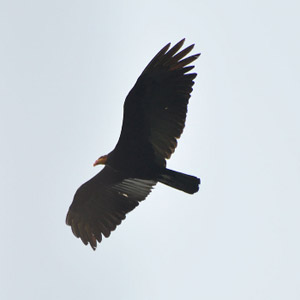Pratique | Débuter
L’utilisation des ascendances thermiques et dynamiques par les oiseaux

Les rapaces, comme ce Grand Urubu (Cathartes melambrotus), profitent des ascendances thermiques pour minimiser leurs efforts.Photographie : Don Faulkner / Wikipedia
Introduction
Si vous décidez un jour de vous rendre sur un grand site d’observation de la migration des rapaces (comme Organbidexka en France, Eilat en Israël, Gibraltar dans le sud de l’Espagne ou Hawk Mountain en Pennsylvanie), vous verrez des oiseaux s’élever en décrivant une spirale, sans battre des ailes. Ils semblent suivre une rampe invisible. Ces oiseaux profitent des ascendances thermiques.
Un phénomène proche est observé dans les endroits où le vent, butant contre un relief, est dévié vers le sommet de celui-ci, créant cette fois une ascendance dynamique. Des ascendances similaires existent aussi en mer, et les oiseaux qui les utilisent, comme les albatros et les puffins, pratiquent le vol à voile en mer.
Abstract
Imagine you are watching birds in a famous spot for the migrations of raptors (Eilat, Gibraltar, …). You may see a kettle of large birds circling in the air above you, their wings outstretched and motionless, their bodies slightly tilted. What you are seeing is the act of gaining altitude using rising currents of air called thermals. The act of “thermalling” refers to the use of columns of warm rising air to gain altitude. Thermals are the result of the sun hitting the ground then warming the surrounding air creating a concentrated or “hot” spot. Since warm air rises, raptors and sailplanes utilize these circular rising currents to go upwards. The cumulus clouds that tend to form at the top of the thermal can often be used to identify their location.
For raptors, the challenge in soaring is finding air currents that are rising faster than they are descending. Fundamentally, raptors use thermal lift to attain altitude then soar for as far as possible while descending, then riding the next available thermal to gain altitude again.
Besides using thermals, raptors also use updrafts made by wind that is deflected off ridges. The longer the ridge and the steadier the wind, the farther a raptor can fly with little use of its own energy.
The same type of phenomenon also exists on the sea.
Poursuivez la lecture de cet article, en vous abonnant dès maintenant !
Découvrez les Archives d’Ornithomedia.com
Pour seulement 10,00 €TTC/an (ou 6,00 € les 6 mois)
Profitez de plusieurs centaines d’articles en accès illimité et sans aucun engagement.
Compléments
Ouvrages recommandés
- La migration des oiseaux : Comprendre les voyageurs du ciel de Maxime Zucca
- Le Guide Ornitho de L. Svenssson et al
- A vol d’oiseau – la migration des oiseaux de Michel Francesconi et Capucine Mazille




Aucun commentaire sur ce sujet
Participer à la discussion !